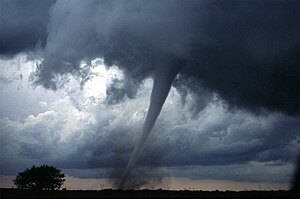
- Image via Wikipedia
In the wake of the tornadoes that killed throughout the United States, it seems very appropriate, to share some information that “debunks” three popular myths regarding tornado safety. Please take the time to read this information. Many of us who are familiar with Midwest weather can get easily comfortable in our tornado safety knowledge, but some of what we know to be the “best practices” could be, in fact, dangerous myths. Listed below are some tornado safety myths debunked by Roger Edwards from the Storm Prediction Center.
1. Long ago, I was told to open windows to equalize pressure. Now I have heard that’s a bad thing to do. Which is right? Opening the windows is absolutely useless, a waste of precious time, and can be very dangerous. Don’t do it. You may be injured by flying glass trying to do it. And if the tornado hits your home, it will blast the windows open anyway.
2. I have a basement, and my friend said to go to the southwest corner in a tornado. Is that good? Not necessarily. The SW corner is no safer than any other part of the basement, because walls, floors and furniture can collapse (or be blown) into any corner. The “safe southwest corner” is an old myth based on the belief that, since tornadoes usually come from the SW, debris will preferentially fall into the NE side of the basement. There are several problems with this concept, including:
- Tornadoes are not straight-line winds, even on the scale of a house, so the strongest wind may be blowing from any direction; and
- Tornadoes themselves may arrive from any direction.
In a basement, the safest place is under a sturdy workbench, mattress or other such protection — and out from under heavy furniture or appliances resting on top of the floor above.
3. I’ve seen a video of people running under a bridge to ride out a tornado. Is that safe? Absolutely not! Stopping under a bridge to take shelter from a tornado is a very dangerous idea, for several reasons:
- Deadly flying debris can still be blasted into the spaces between bridge and grade — and impaled in any people hiding there.
- Even when strongly gripping the girders (if they exist), people may be blown loose, out from under the bridge and into the open — possibly well up into the tornado itself. Chances for survival are not good if that happens.
- The bridge itself may fail, peeling apart and creating large flying objects, or even collapsing down onto people underneath. The structural integrity of many bridges in tornado winds is unknown — even for those which may look sturdy.
- Whether or not the tornado hits, parking on traffic lanes is illegal and dangerous to yourself and others. It creates a potentially deadly hazard for others, who may plow into your vehicle at full highway speeds in the rain, hail, and/or dust. Also, it can trap people in the storm’s path against their will, or block emergency vehicles from saving lives.
The people in that infamous video were extremely fortunate not to have been hurt or killed. They were actually not inside the tornado vortex itself, but instead in a surface inflow jet — a small belt of intense wind flowing into the base of the tornado a few dozen yards to their south. Even then, flying debris could have caused serious injury or death. More recently, on 3 May 1999, two people were killed and several others injured outdoors in Newcastle and Moore OK, when a violent tornado blew them out from under bridges on I-44 and I-35. Another person was killed that night in his truck, which was parked under a bridge.
These are three of the most common myths in tornado safety. Hopefully this information has been helpful.
Ellis Library Security
![Reblog this post [with Zemanta]](http://img.zemanta.com/reblog_e.png?x-id=ffb316ce-02d8-4e16-80be-8bb673905c73)